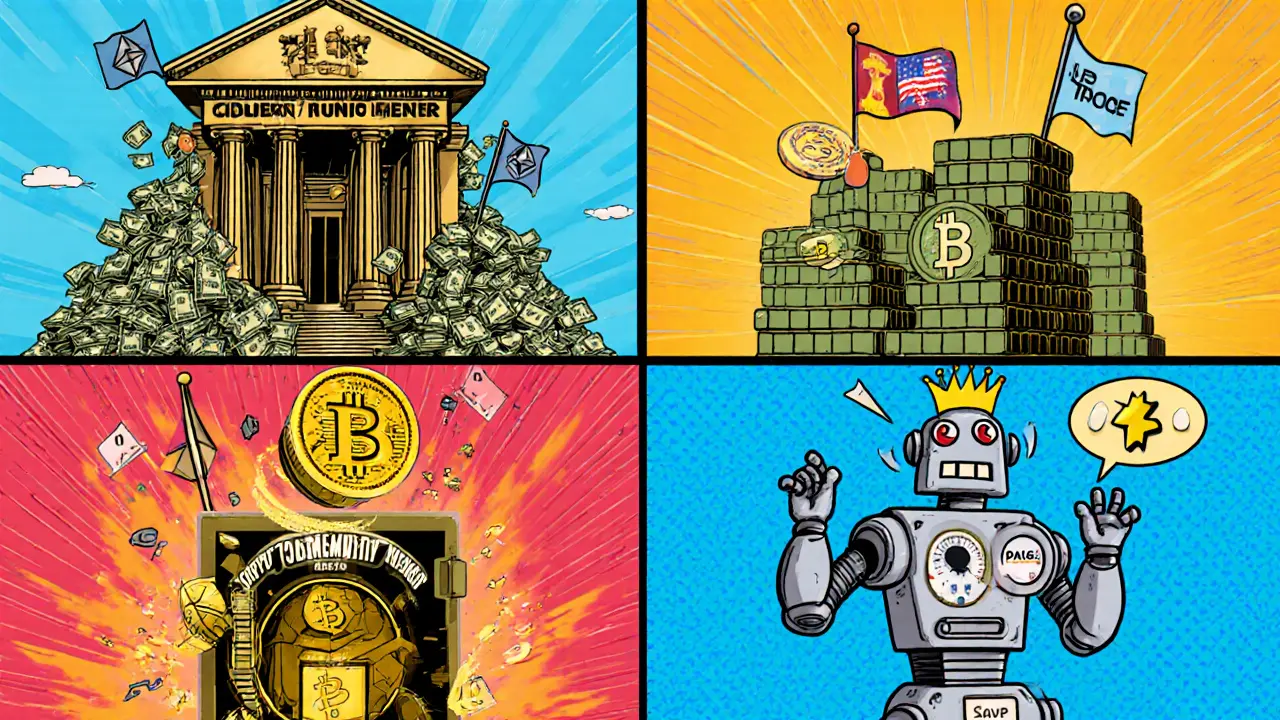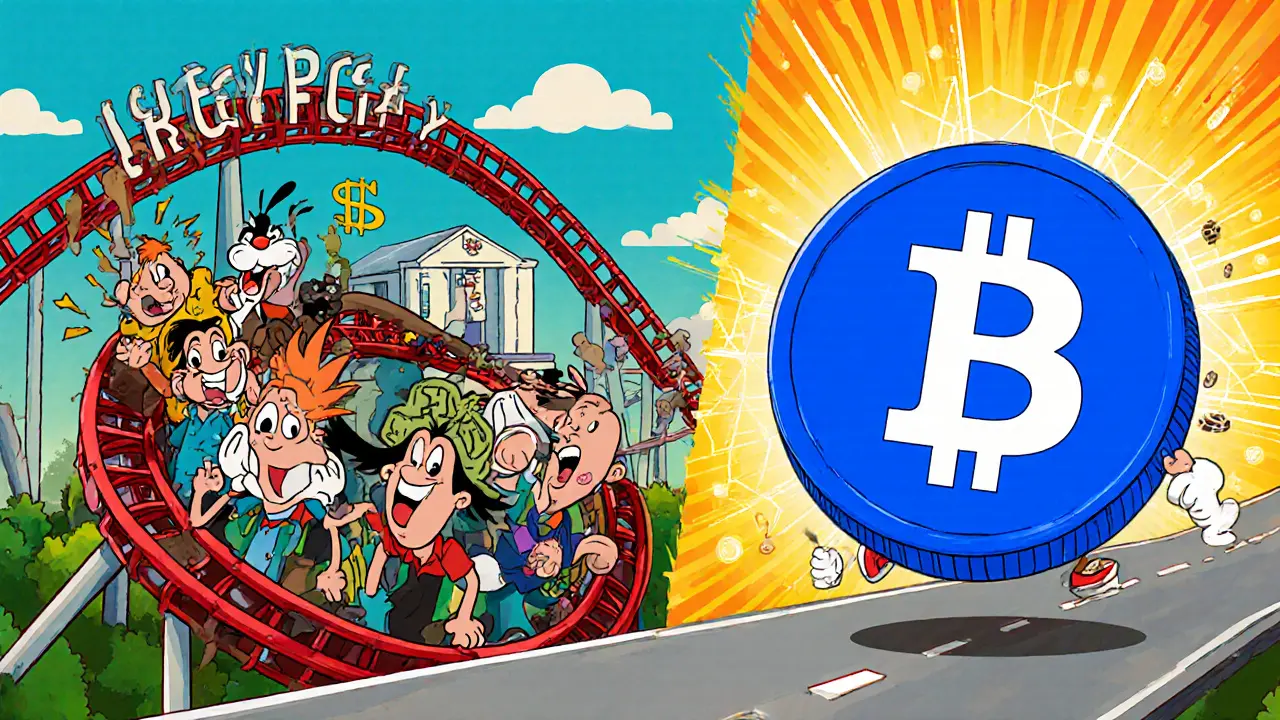Stablecoin Type Explorer
Select a stablecoin type below to learn about its features, collateral, risks, and best use cases.
| Family | Typical Peg | Collateral | Risk Level | Best Use Case |
|---|---|---|---|---|
| Fiat-pegged | USD, EUR | Cash & short-term Treasury bills | Low | Payments, remittances |
| Crypto-collateralized | USD-equivalent | Over-collateralized crypto (ETH, BTC) | Medium | DeFi lending, hedging |
| Commodity-backed | Gold, silver | Physical commodity in vaults | Low-Medium | Wealth preservation, tokenized assets |
| Algorithmic | Self-adjusting supply | No reserves | High | Speculative experiments |
When crypto prices swing wildly, stablecoins are a special class of digital money designed to stay near a fixed value. They try to give you the speed and low cost of blockchain while cutting out the roller‑coaster that makes Bitcoin or Ether hard to use for everyday purchases.
What Exactly Are Stablecoins?
Stablecoins are a type of cryptocurrency that is pegged 1:1 to a more stable reference asset, most often a fiat currency like the U.S. dollar (USD). The peg can also be tied to short‑term U.S. Treasury bills, gold, or a basket of other assets.
Because the value is meant to stay constant, merchants can accept them without worrying about sudden losses, and users can move money across borders in seconds, not days.
How Do They Keep Their Value Stable?
There are four main design families, each with its own way of honoring the peg.
Fiat‑Pegged Stablecoins
These hold real cash or cash‑equivalents in a bank. For example, USDC keeps a reserve of U.S. dollars and short‑term Treasury securities at The Bank of New York Mellon. USDT follows a similar model, although its exact reserve composition has been a topic of debate.
Crypto‑Collateralized Stablecoins
Instead of cash, these lock up other cryptocurrencies as collateral. DAI is the poster child: users deposit Ether and other tokens into the MakerDAO smart‑contract system, which then mints DAI. The system over‑collateralizes (typically 150‑200% of the DAI issued) so that even if the underlying crypto price drops, enough value remains to redeem every DAI.
Commodity‑Backed Stablecoins
These tie each token to a physical commodity. PAX Gold (PAXG) represents one troy ounce of gold stored in a professional vault, while Tether Gold (XAUT) does the same for gold under a different issuer.
Algorithmic Stablecoins
Instead of holding any reserve, algorithmic designs change the supply of the token to match demand. The most famous (and disastrous) example was TerraUSD (UST), which collapsed in May2022 when its supply‑adjustment code couldn’t stop a rapid run on the coin.

Why Treasury Bills Matter
Since 2022, the biggest fiat‑pegged stablecoins have poured billions into short‑term U.S. Treasury bills. These bills mature in less than 93 days, offering safety, liquidity, and a predictable yield. The inflow of stablecoin capital has become large enough to affect short‑term Treasury yields, creating a feedback loop: higher yields attract more stablecoin backing, which in turn drives demand for more Treasury issuance.
Practical Benefits You Can Use Today
Here’s why businesses and regular folks are adopting them:
- Low‑cost, fast cross‑border transfers: Sending USDC from NewZealand to the U.S. can settle in minutes for a few cents, versus days and fees with traditional banks.
- Programmable money: Smart contracts can auto‑settle invoices, escrow, or interest‑bearing accounts without a middle‑man.
- Stable store of value: Traders can park volatile crypto profits in USDC while waiting for the next market move.
- DeFi accessibility: Lending platforms accept DAI as collateral, letting users earn yields that rival traditional savings accounts.
According to analysts at J.P. Morgan, stablecoins act like “digital cash on steroids,” moving faster and cheaper than legacy payment rails, especially after traditional markets close.
Risks and Challenges
Stability isn’t guaranteed. The biggest threats are:
- Run risk: If many holders try to redeem a fiat‑pegged coin at once, the issuer must liquidate reserves quickly. The TerraUSD failure proved how quickly a panic can spread.
- Regulatory uncertainty: Governments are still drafting laws. Some jurisdictions may demand daily audits, while others could ban certain types outright.
- Collateral quality: Coins that rely on lower‑quality assets (e.g., corporate paper) can lose peg faster than those backed by Treasury bills or cash.
Transparency helps. Public attestations from reputable auditors boost confidence, while opaque reserve practices erode it.

Comparison of Stablecoin Types
| Family | Typical Peg | Collateral | Risk Level | Best Use Case |
|---|---|---|---|---|
| Fiat‑pegged | USD, EUR | Cash & short‑term Treasury bills | Low | Payments, remittances |
| Crypto‑collateralized | USD‑equivalent | Over‑collateralized crypto (ETH, BTC) | Medium | DeFi lending, hedging |
| Commodity‑backed | Gold, silver | Physical commodity in vaults | Low‑medium | Wealth preservation, tokenized assets |
| Algorithmic | Self‑adjusting supply | No reserves | High | Speculative experiments |
Future Outlook
The next few years will shape whether stablecoins become a mainstream payment layer or remain a niche tool. Expect three big trends:
- Regulatory clarity: Many countries are drafting “stablecoin charters” that require real‑time audits and clear redemption rights.
- Deeper banking integration: Major banks are already piloting USDC settlements for wholesale payments, which could bring lower fees and instant clearing to corporate finance.
- Improved transparency tech: On‑chain proof‑of‑reserve systems, powered by zero‑knowledge proofs, aim to let anyone verify that the backing assets truly exist without exposing sensitive banking data.
If these developments stick, stablecoins could finally solve the crypto volatility puzzle while fitting neatly into the existing financial ecosystem.
Frequently Asked Questions
How does a fiat‑pegged stablecoin stay at $1?
The issuer holds reserves-usually cash and short‑term Treasury bills-equal to the number of tokens in circulation. When someone wants to redeem a token, the issuer swaps the token for the underlying fiat, keeping the supply and reserves balanced.
Can I earn interest on stablecoins?
Yes. Many DeFi platforms let you lend USDC, DAI, or USDT and earn yields that range from 2% to 12% depending on market demand and risk appetite. Traditional banks are also starting to offer interest‑bearing accounts for selected stablecoins.
What happened to TerraUSD?
TerraUSD was an algorithmic stablecoin that tried to keep $1 by expanding or contracting supply based on market pressure. In May2022, a massive sell‑off overwhelmed the algorithm, the peg broke, and the token collapsed, wiping out billions of dollars.
Are stablecoins regulated?
Regulation varies by country. The U.S. is working on a “stablecoin charter” that would require regular audits and clear redemption rights. The EU’s MiCA framework already imposes strict reserve‑verification rules. Always check local guidance before using large amounts.
Which stablecoin should I choose for everyday spending?
For most users, a fiat‑pegged coin like USDC or USDT works best because they have the deepest liquidity, the most transparent reserves, and wide merchant acceptance.

Reading through the stablecoin overview reminds me how much the crypto space still craves a reliable store of value. The breakdown of fiat‑pegged versus algorithmic coins is clear, and it shows why most users stick with the low‑risk options. I’m especially interested in how short‑term Treasury bills are now a backbone for many fiat‑pegged tokens. It feels like a step toward mainstream acceptance.
Wow!! This post nails why stablecoins are the future of payments!!! The low‑cost, near‑instant transfers are exactly what we need in today's fast‑paced world!!! Keep the info coming!!!
Whoa, talk about a roller‑coaster of a tech evolution! The way fiat‑pegged stablecoins tether real cash to the blockchain feels almost magical. Meanwhile, the crypto‑collateralized ones, like DAI, are showing that over‑collateralization can actually work. I love the drama of algorithmic coins-watch them burn or soar! All in all, the article paints a vivid picture of where we stand.
Sure, stablecoins look solid on paper, but remember every peg can crack under pressure. The fiat‑backed ones rely on trust in banks, and the algorithmic ones have already shown their fragility. I’d say keep a healthy skepticism handy.
Yo, this is cool. Stablecoins make moving money feel like sending a text. Good stuff.
Honestly, the crypto‑world needs more moral responsibility. Pushing algorithmic stablecoins without proper audits is reckless. Regulators must step in now, or we’ll see another collapse. The article should have emphasized the ethical side more.
It is imperative to approach the proliferation of stablecoins with rigorous academic scrutiny; the prevailing narrative that fiat‑backed tokens are inherently safe is, at best, an oversimplification. While the integration of short‑term Treasury securities provides a veneer of security, the systemic risk associated with mass redemption events cannot be dismissed lightly. Moreover, the absence of transparent, real‑time reserve verification engenders a fertile ground for market manipulation. Consequently, any assertion that stablecoins will seamlessly replace traditional payment rails is, frankly, premature.
Stablecoins represent a fascinating convergence of traditional finance and blockchain technology, and their evolution is worth a deep dive. The article rightly points out that fiat‑pegged tokens, such as USDC and USDT, are anchored by reserves of cash and short‑term Treasury bills, which provide a relatively low‑risk foundation. However, the reliance on centralized custodians introduces counterparty risk that cannot be ignored. Crypto‑collateralized stablecoins like DAI take a different approach by over‑collateralizing assets, typically at 150‑200%, to safeguard against volatility in the underlying crypto. This method, while innovative, still inherits the price swings of the very assets it aims to stabilize, making it a medium‑risk proposition. Commodity‑backed stablecoins, such as PAXG, tie their value to physical assets like gold, offering a hedge against inflation and a store of wealth, yet they also involve logistical challenges related to storage and verification. Algorithmic stablecoins aim for elegance by adjusting supply through code without reserves, but history has shown that this model is highly vulnerable to market panic, as evidenced by the TerraUSD collapse. The integration of short‑term U.S. Treasury bills into fiat‑pegged stablecoins has begun to influence Treasury yields, creating a feedback loop that may affect broader monetary policy. From a user perspective, stablecoins enable near‑instant, low‑cost cross‑border transfers, which is a clear advantage over traditional banking channels. They also allow for programmable money via smart contracts, unlocking new financial products like automated escrow and decentralized lending. Nonetheless, the risk of a run-mass redemption requests draining reserves-remains a critical failure point, especially for less transparent issuers. Regulatory landscapes are evolving, with jurisdictions like the EU implementing the MiCA framework to enforce strict reserve verification, while the U.S. contemplates a stablecoin charter. Transparency through regular audits and on‑chain proof‑of‑reserve mechanisms can bolster confidence among users. In conclusion, while stablecoins offer a practical solution to crypto volatility, their long‑term success hinges on robust risk management, clear regulatory guidance, and continued innovation in reserve verification technologies.
Solid overview; the risk tiers match what we see in the market.
Great read! 👍👍 This really clears up the stablecoin landscape. 😊
Nice summary. I’ll definitely keep an eye on USDC.
From a technical standpoint, the on‑chain proof‑of‑reserve systems could be a game‑changer. If we can verify reserves without leaking private data, the trust deficit would shrink dramatically. That said, the complexity of zk‑SNARKs and related cryptography means implementation will be non‑trivial. Still, the roadmap laid out in the article aligns with the direction I’ve been advocating on my own research blog.
What a helpful guide! I appreciate the balanced tone and the clear tables. This will help many newcomers navigate the stablecoin space!!!
For anyone just getting started, remember that liquidity matters as much as the peg. Choosing a stablecoin with deep market depth will ensure you can move in and out without slippage. Also, keep an eye on the audit reports-transparent issuers usually publish them monthly.
i think u should check the reserve reports more often, im not 100% sure about some of these.
Alright, drama alert! The algorithmic stablecoins are the wild west of the crypto world-think of them as the fireworks that look beautiful until they blow up in your face. 🎆💥
i dunno if i trust these at all lol. seems risky.
Stablecoins, when properly audited and fully collateralized, provide a reliable means of transferring value across borders with minimal friction. Their adoption by major financial institutions signals a shift toward integrating blockchain solutions within traditional banking frameworks.
Patriots, imagine a world where our dollar isn’t diluted by endless crypto experiments. Stablecoins backed by real U.S. assets keep our sovereignty intact and protect our economy from foreign digital noise.
Oh sure, just throw another “stable” token at the problem and everything will be fine-because history has shown that’s how regulators love to work.
Let me pull the curtain back on the whole stablecoin narrative. The mainstream portrayal suggests these tokens are bullet‑proof, yet the underlying infrastructure is riddled with hidden vulnerabilities. Centralized custodians keep reserve accounts under the radar, and the audit reports often lack the granularity needed for genuine scrutiny. Moreover, the very act of funneling billions into short‑term Treasury bills creates a feedback loop that can unintentionally distort monetary policy-a subtle yet profound impact on the broader economy. When a mass redemption event occurs, the buffer may evaporate faster than anticipated, leading to a cascading failure across platforms that depend on the same reserves. Add to that the regulatory vacuum; many jurisdictions are still drafting cryptic guidelines that leave room for interpretation, which, in turn, invites opportunistic actors to exploit loopholes. Even the most reputable fiat‑pegged stablecoins have faced controversies over their actual reserve composition, prompting questions about the transparency of their custodial partners. The algorithmic experiments, while innovative, serve as stark reminders that code alone cannot guarantee stability without solid economic backing. In short, the veneer of stability is often thin, and the community must demand more rigorous, real‑time proof‑of‑reserve mechanisms if we are to avoid repeating past failures.
The article’s section on Treasury‑backed stablecoins is spot on. Recent data shows that as more dollars flow into short‑term Treasuries, yields experience slight upward pressure, which can benefit investors yet also increase the cost of maintaining the peg. A transparent, auditable reserve structure will be crucial for building trust moving forward.
From a compliance perspective, integrating stablecoins into existing financial systems requires robust KYC/AML procedures. Institutions must verify both the on‑chain transaction data and the off‑chain reserve holdings to satisfy regulatory expectations. Failure to do so could result in significant legal penalties.
In short, fiat‑pegged stablecoins dominate due to liquidity, while algorithmic models remain high‑risk experiments.
Appreciate the deep dive-your explanation about over‑collateralization in DAI helped clarify why its risk profile sits between fiat‑backed and algorithmic tokens.